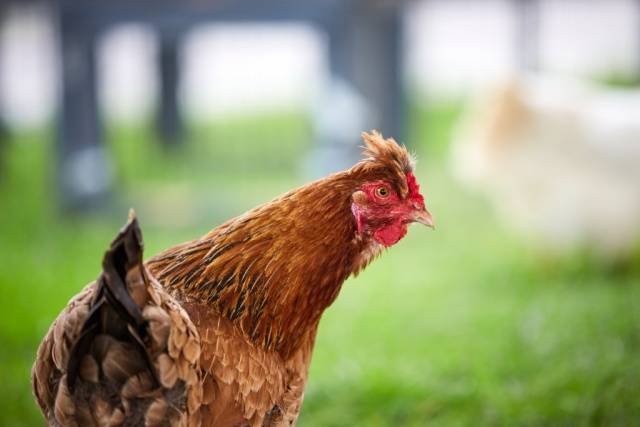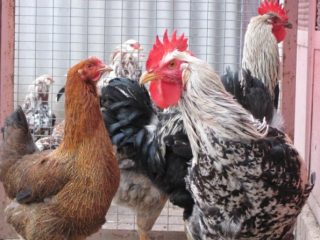Content
The Kuchin anniversary breed of chickens is an achievement of domestic breeders. Work on breeding the breed began in the 50s and continues to this day. The main focus of the work is to improve the productive characteristics of the Kuchin breed. The priority areas in breeding work are: improving the quality of eggs and shells, the viability of chickens and adults, reducing feed costs without changing the quality of products, improving the qualities of poultry aimed at producing offspring.
Let's compare some indicators of the Kuchin breed by year:
Egg production: 2005 - 215 pieces, 2011 - 220 pieces;
Safety of young animals: 2005 – 95%, 2011 – 97%;
Hatching of young animals: 2005 - 81.5%, 2011 - 85%.
The indicators are improving year by year. The Kuchinsky breed of chickens is a prize-winner at agricultural exhibitions; experts recognize it as the best breed for production.
Kuchin anniversary chickens were bred by breeders of the Kuchinsky breeding plant with the participation of specialists from the Timiryazev Academy, as well as the Poultry Technological Institute.
Foreign breeds of chickens: striped plymouth rocks ,new hampshires, leghorns, rhode islands, Austrolorps passed on hereditary traits to the Kuchin breed, characterized by high productivity of eggs and meat. A Liven chickens from the Oryol region they passed on to the Kuchinsky people their high adaptability to local conditions. About the Kuchin breed, watch the video:
Description of the breed
Rooster of the Kuchin breed: has a leaf-shaped comb with 5 separate teeth, erect. Its base follows the contour of the head. The beak is strongly curved and of medium size. The eyes are shiny, convex, round in shape.
The head and neck are of medium size, the neck is heavily feathered. The back is wide, covered with elongated feathers. The tail is of medium length, the tail feathers are wide and overlap each other. The tail feathers are curved. The wings are pressed to the body, the lower edge is horizontal. The chest is massive, rounded. The legs are strong, moderately spaced, the legs are muscular. The bird has considerable weight.
Kuchin chicken: The leaf-shaped comb is small in size with 5 teeth, straight, in the mottled Kuchin chickens the comb hangs down from the middle part. The eyes are bulging and round. The neck is densely feathered and gradually tapers towards the head. The length and width of the back exceed the average size. The tail is small.
Breed color
In the description of the Kuchin anniversary chicken breeds There are 2 types of coloring.
- Double contoured: fan of mane feathers, shiny red. Black color along the shaft, the shaft of the feather and the narrow border along it are bright red. The neck is black in front, golden on top. The tail feathers are black with a greenish tint, the coverts are light beige. The wings are mostly black with a rufous edge. The belly has dark gray plumage. The undergrowth is dark gray. The photo shows representatives of the Kuchinkas with the first color option.
- Bordered variety: The feathers are a bright golden color with black stripes along the shaft of the feather, which are connected to a flared black patch at the tip. These feathers are on the head, neck and chest. The feathers on the back are a rich golden brown color. In the tail, the tail feathers are black with a greenish tint, the coverts are golden brown-beige with a black stripe along the shaft. The wings are black with a golden spot along the axis. The belly is black-gray, the underparts are dark gray. How they look, look at the photo.
The coloring of Kuchin chickens is autosex; at one day of age, the sex of the chickens can be easily determined by color with an accuracy of 95%. The cockerels have light-colored wings and a light yellow head. Chickens are darker in color with stripes on the back and spots on the head.
Production figures
Kuchin chickens are meat and egg oriented. The quality of the products is very high, the meat has increased taste. Kuchin chickens are in demand among the population, as they have high production rates.
At the age of 20 weeks, roosters weigh 2.4 kg, hens 2 kg; at the age of 56 weeks, roosters weigh 3.4 kg, hens 2.7 kg. The meat performance of the Kuchin breed is very high.
Laying hens produce 215-220 eggs per year. Eggs weighing up to 60 g are light beige or cream with a pinkish tint, the shell is strong. Peak egg production occurs at 9 months of age. They begin to lay eggs at the age of 5.5 – 6 months. Adult Kuchin chickens may stop laying eggs for a short period of time due to molting.
Pros of the breed
Private households are happy to have chickens of the Kuchin breed. The most important thing is, of course, high production indicators, but there are also a number of positive features of the breed.
- Kuchin chickens are friendly, balanced, have a good disposition, and adapt well to people and new living conditions;
- Unpretentious to food. They love chopped green mass and can get their own food;
- Rapid puberty. They lay eggs with a high level of viability;
- Laying hens have not lost their brooding instinct and can independently breed their offspring;
- At the age of 90 days you can begin to form a breeding herd. Cockerels at this time weigh up to 1.5 kg;
- They tolerate low temperatures well and lay year-round;
- The bright color of the Kuchin breed will decorate your yard.
Features of feeding
Until 45 weeks, it is necessary to increase the amount of feed, but reduce its nutritional value. This contributes to the proper formation of the reproductive system of Kuchin chickens and the supply of nutrients in the body.
After 45 weeks, chickens stop growing. More calcium needs to be added to the diet to improve shell quality. Sources of calcium include shells, chalk, limestone, cottage cheese, milk, yogurt.
The presence of phosphorus in the diet is important for chickens. Chickens obtain phosphorus from bone meal, bran, cake, and fish meal.
The most complete foods are of animal origin: cottage cheese, milk, bone flour. But it is not economically profitable to use them, since they are quite expensive. Therefore, combine food of plant and animal origin.
Chickens should consume feed with an energy value of 310 kcal per day. Otherwise, egg production will decrease, weight gain will stop, protective immune forces will decrease, and cannibalism may occur.
The main thing is that the bird does not need to be overfed so that obesity does not develop.In this state, chickens stop laying eggs and the quality of the meat suffers. Various diseases may develop.
Important! Keep the coop clean. Do regular cleaning.
Birds must have clean water in their drinking bowl. For bedding, use sawdust and shavings. This is beneficial from an economic point of view and very convenient when cleaning the chicken coop.
Conclusion
The Kuchinsky breed is an achievement of domestic targeted selection. Its distinctive features are high egg production and meat of excellent taste. The breed gives farmers the opportunity to engage not only in production, but also in breeding the breed for sale. A high percentage of offspring survival rate, which is genetically determined, will protect you from financial losses. And another important goal of the breeders of the Kuchinskoye breeding plant: reducing production costs, was achieved. The Kuchin Jubilee breed is very unpretentious in food and living conditions.
Reviews
Life somehow doesn't get any better. We decided to buy chickens. To always be with your meat and eggs. We live in the private sector and have equipped a chicken coop. We bought day-old chicks, it’s more profitable. Kuchin Jubilee breed. They reasoned that purebred Kuchin chickens had, after all, undergone selective selection and should lay eggs well. We were not disappointed in our expectations. Eggs have become a permanent part of the family's diet. Our own with a bright yolk cannot be compared with store-bought ones.
















